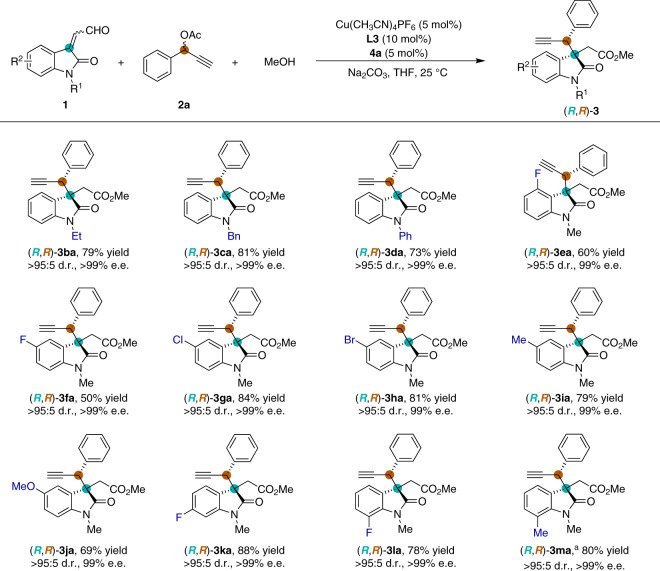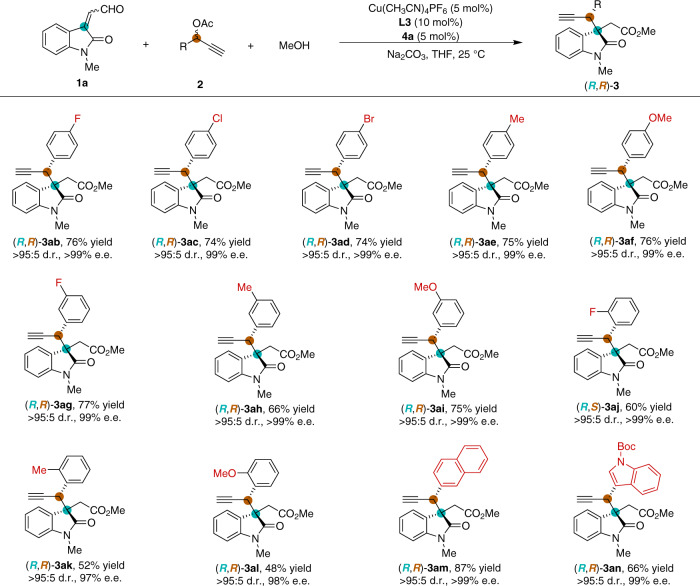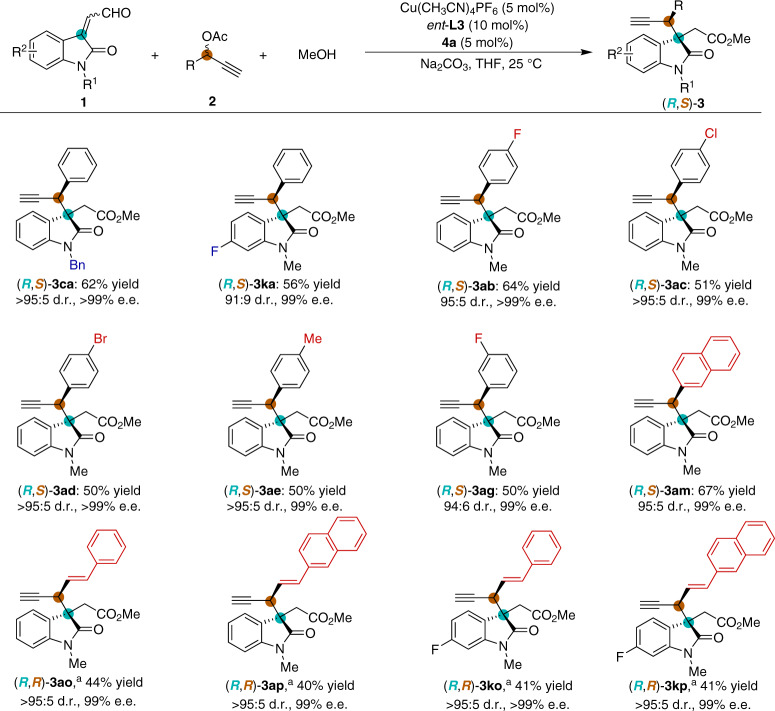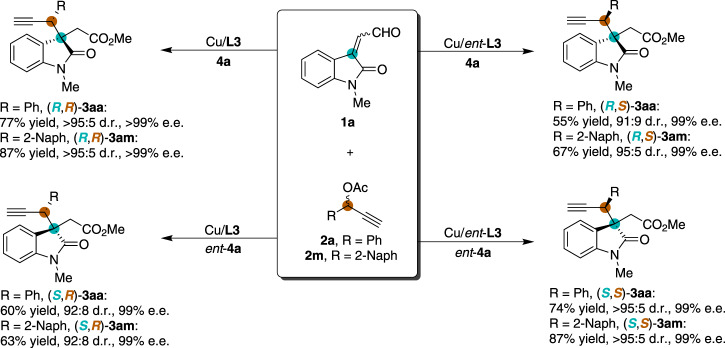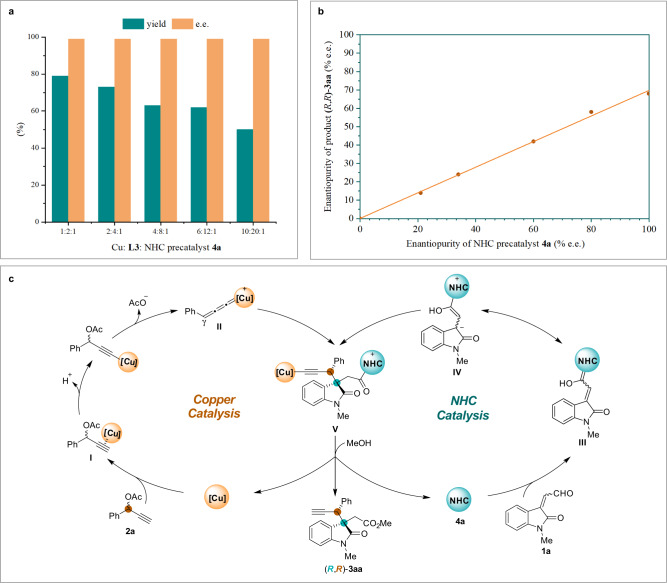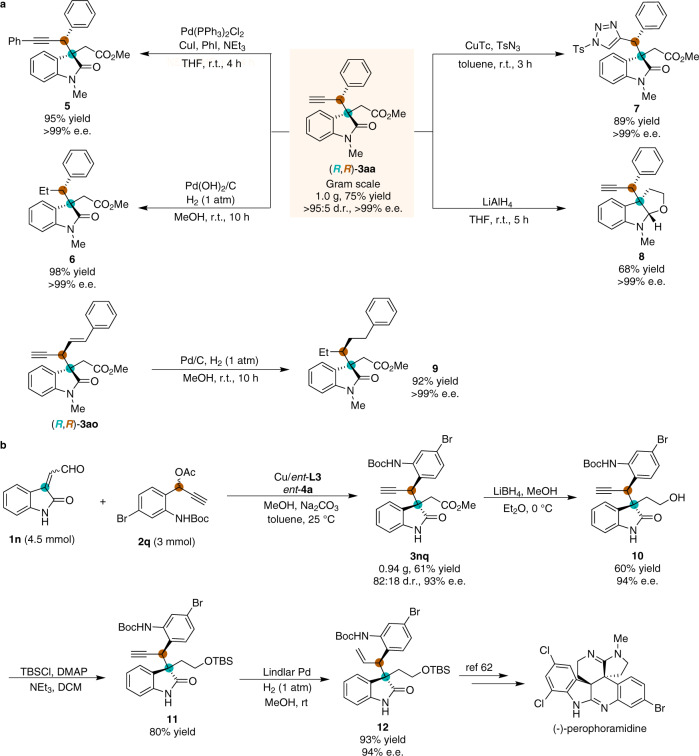Abstract
Despite that asymmetric stereodivergent synthesis has experienced great success to provide unusual processes for the creation of chirality complexity, concepts appliable to asymmetric stereodivergent catalysis are still limited. The dependence on the unusual capacity of each catalyst to precisely control the reactive site planar in the region poses unparalleled constraints on this field. Here, we first demonstrate that the chiral Cu-allenylidene species can participate in the stereodivergent propargylic alkylation of enals, in concert with chiral N-heterocyclic carbenes (NHCs). Thus, all four stereoisomers were obtained with excellent enantioselectivity and diastereoselectivity (up to >99% e.e. and >95:5 d.r.) from the same starting materials by simply altering chiral Cu-Pybox complex and NHC combinations. The rich chemistry workable in the products enables the structurally diverse synthesis of chiral functional molecules and holds great potential in alkaloid synthesis, as showcased by the preparation of the key building block to access (-)-perophoramidine.
Subject terms: Asymmetric catalysis, Synthetic chemistry methodology
The ability to construct multiple stereocenters in a modular fashion is an important goal of synthetic organic chemistry. Here the authors present a method to construct oxindoles in four stereoisomers with high enantioselectivity and diastereoselectivity from the same starting materials by using cooperative copper- and organocatalysis.
Introduction
Contiguous carbon stereogenic centers prevalently distribute in complex natural products and important bioactive compounds, and their absolute and relative configurations commonly exert some impact on the shape of the structurally complex molecules, which are closely related to the properties and biological activities1. Stereodivergent synthesis2–7, a direct access to all product stereoisomers incorporating vicinal stereogenic centers from the same set of starting materials, offers more opportunities for the investigation of structure−activity relationships to advance drug discovery and chemical biology study1,8. The recent decades have witnessed significant advances in cooperative catalysis, providing a preponderance of activation modes and stereochemical options to render asymmetric reactions9–13, and the robustness of each individual chiral catalyst allocates cooperative catalysis to enable stereodivergent synthesis. Carreira and coworkers first introduced and validated the concept by an asymmetric catalytic α-allylation of branched aldehydes14. All possible stereoisomers of the product were obtained by the orthogonal permutation of chiral amine and iridium complex of chiral phosphoramidite. Since this seminal work, substantial progress has been made on catalytic stereodivergent synthesis15–33 based on the cooperative action of different catalytic principles. In particular, the asymmetric coupling events of transient nucleophiles bonded with either chiral organocatalysts or Lewis acids with electrophilic π-allyl Ir14–23,25–29/Rh24/Pd30–32 intermediates have been intensively investigated and turn out to be the most general platforms to establish stereodivergent synthesis (Fig. 1a). While much has been accomplished, the exploration of chiral catalyst-coupled electrophiles beyond π-allyl metal complexes remains to be developed33 and is greatly desirable for broadening the domain of stereodivergent catalytic synthesis.
Fig. 1. Stereodivergent synthesis via dual catalysis.
a Representative stereodivergent synthesis via cooperative catalysis, chiral catalyst (Cat*). b NHC/transition metal cooperatively catalyzed enantioselective annulation reactions, substrate (sub). c Asymmetric propargylic substitution reactions mediated by chiral Cu-allenylidene complexes. d This work: the first stereodivergent propargylation of enals via cooperative NHC/copper catalysis, leading to all four stereoisomers with excellent optical purity.
N-Heterocyclic carbene catalysis has seen appreciable research activity with the realization of abundant enantioselective transformations34–37. Recently, considerable efforts have been invested in the integration of NHC and transition metal catalysis38–40 to access new reactions22,23,41–49. However, stereoselective annulation reactions to produce lactones and lactams appear to be easily accessible and most successful, presumably due to the requirement for an intramolecular acyl transfer to a proximal nucleophile to facilitate the regeneration of the NHC catalyst (Fig. 1b). Over the past decades, copper-catalyzed asymmetric propargylic substitution reaction has proven to be a powerful method to assemble carbon-carbon and carbon-hetero bonds, wherein chiral ligands are employed to control the stereoselectivity (Fig. 1c)50–54. In this context, we anticipated that the coupling of the key Cu-allenylidene intermediate I and an NHC-bound nucleophile II55 using an external nucleophile as acyl acceptors56 might occur, leading to an NHC/copper cooperatively catalyzed asymmetric propargylation process (Fig. 1d). More significantly, the chiral Cu-allenylidene species I would be an ideal electrophile with high local stereocontrol50–54, and thus presumably enables access to stereodivergent catalytic synthesis, in concert with the chiral NHC-mediated nucleophilic event. However, such a stereodivergent propargylation reaction has not been described, yet. As a consequence, success in stereodivergent action of Cu-allenylidene species with NHC-bonded nucleophiles would add a new dimension to asymmetric catalysis. Herein, we report the first stereodivergent propargylic alkylation reaction of propargylic acetates with isatin-derived enals enabled by cooperative catalysis of chiral NHCs and copper complexes to deliver oxindole derivatives with excellent diastereoselectivity and enantioselectivity. The orthogonal alteration of enantiomers of NHCs and copper catalysts allows access to all four stereoisomers of the products.
Results
Optimization studies
To test the validity of our hypothesis, we began our investigation into the stereoselective propargylic alkylation reaction of isatin-derived enal 1a with propargylic acetate 2a under NHC/copper cooperative catalysis (Table 1 and Supplementary Tables 1–6). As expected, the desired propargylation oxindole product (R,R)-3aa was obtained in 70% yield with 93:7 diastereomeric ratio (d.r.) and 96% enantiomeric excess (e.e.) through the synergy of a chiral NHC catalyst generated in situ from 4a and a copper complex with a chiral pyridine bis(oxazoline) (Pybox) ligand L1, by using methanol as the nucleophile required for the catalyst turnover (entry 1). Screening of chiral organocatalysts (entries 1–6, and Supplementary Table 1) revealed that the chiral NHC precatalyst 4a appeared to be the most efficient Lewis base catalyst capable of delivering the highest diastereo- and enantioselectivities (entry 1). Copper salts had a considerable effect on the reaction performance and Cu(CH3CN)4PF6 was identified as the optimal metal catalyst precursor (Supplementary Table 2). The evaluation of Pybox L2-L4 and other ligands (entries 7−9, and Supplementary Table 3) found that the combination of chiral NHC precatalyst 4a with Pybox L3 led to a significant enhancement in the stereoselectivity (entry 8). Either base or temperature also exerts impacts on the reaction (Supplementary Tables 4, 5). The variation of solvents indicated that the reaction gave the best results in tetrahydrofuran (entry 11) as compared to that in any other counterparts tested (entries 8, 10, 12 and Supplementary Table 6). Control experiments verified the necessity of each member of the combined catalyst system (entries 13−15), thus less than 5% yield was observed for the desired product in the absence of any of the NHC precatalyst, copper salt, and Pybox ligand.
Table 1.
Reaction optimization.
 | ||||||
|---|---|---|---|---|---|---|
| Entrya | 4 | Ligand | Solvent | Yield (%)b | d.r.c | e.e. (%)d |
| 1 | 4a | L1 | Toluene | 70 | 93:7 | 96 |
| 2 | 4b | L1 | Toluene | 20 | 87:13 | 94 |
| 3 | 4c | L1 | Toluene | 76 | 92:8 | 92 |
| 4 | 4d | L1 | Toluene | 74 | 67:33 | 29 |
| 5 | 4e | L1 | Toluene | 22 | 71:29 | 59 |
| 6 | 4f | L1 | Toluene | 83 | 50:50 | 18 |
| 7 | 4a | L2 | Toluene | 42 | 60:40 | 73 |
| 8 | 4a | L3 | Toluene | 51 | >95:5 | 99 |
| 9 | 4a | L4 | Toluene | 39 | 81:19 | 87 |
| 10 | 4a | L3 | DCM | 47 | >95:5 | 99 |
| 11 | 4a | L3 | THF | 79 (77) | >95:5 | >99 |
| 12 | 4a | L3 | MeOH | 22 | 73:27 | 84 |
| 13 | – | L3 | THF | n.d. | – | – |
| 14e | 4a | – | THF | n.d. | – | – |
| 15 | 4a | – | THF | <5 | – | – |
aReaction conditions: Cu(CH3CN)4PF6 (5 mol%) and pyridine bis(oxazoline) ligand L (10 mol%) were stirred in solvent (0.5 mL) at 25 °C for 1 h, then NHC precatalyst 4 (5 mol%), 1a (0.15 mmol), 2a (0.1 mmol), MeOH (0.5 mmol), Na2CO3 (0.1 mmol) and solvent (0.5 mL) were added to the reaction mixture and stirred for 12 h under N2.
bThe yield was determined by 1H NMR spectroscopy (yield of isolated product given within parentheses).
cThe diastereomeric ratio (d.r.) was determined by 1H NMR spectroscopy.
dThe enantiomeric excess (e.e.) was determined by HPLC.
eIn the absence of Cu(CH3CN)4PF6. Mes = mesityl, DCM = dichloromethane, THF = tetrahydrofuran, n.d. = not detected.
Substrates scope with enals
The substrate scope of the asymmetric propargylic substitution reaction with respect to enals was initially investigated under optimized conditions (Fig. 2). The isatin-derived enals with different nitrogen protecting groups were found to be suitable substrates and afforded corresponding products 3ba–3da in high yields and with excellent levels of stereoselectivity (>95:5 d.r. and >99% e.e. for all). The presence of either electron-withdrawing or electron-donating substituents on the isatin ring was allowed to give corresponding products 3ea–3ma in good yields and with excellent diastereo- and enantioselectivities (up to >95:5 d.r. and >99% e.e.).
Fig. 2. Substrate scope of isatin-derived enals.
Reaction conditions: Cu(CH3CN)4PF6 (5 mol%) and pyridine bis(oxazoline) ligand L3 (10 mol%) were stirred in THF (0.5 mL) at 25 °C for 1 h, then NHC precatalyst 4a (5 mol%), 1 (0.15 mmol), 2a (0.1 mmol), MeOH (0.5 mmol), Na2CO3 (0.1 mmol) and THF (0.5 mL) were added to the reaction mixture and stirred for 12 h under N2. Diastereomeric ratio (d.r.) was determined by 1H NMR spectroscopic analysis. Isolated yields. The enantiomeric excess (e.e.) was determined by HPLC. a7.5 mol% of 4a was used.
Substrates scope with propargylic acetates
Substituted propargylic acetates were then examined under the optimized reaction conditions (Fig. 3). A broad range of propargylic acetates 2 bearing electron-withdrawing or electron-donating substituents on para- or meta-position of the benzene ring were well tolerated and gave the desired products 3ab-3ai in high yields and excellent stereoselectivities. In addition, the presence of ortho-substituent at the aryl group of propargylic acetates also underwent an efficient and stereoselective coupling reaction (3aj-3al). Moreover, the asymmetric reaction of both 2-naphthyl and 3-indolyl propargyl acetates proceeded smoothly and furnished the corresponding products (3am and 3an) with >95:5 d.r. and 99% e.e. Unfortunately, the other types of enals failed to undergo the desired reaction (See Supplementary Table 7 for some unsuccessful substrates).
Fig. 3. Substrate scope of propargylic acetates.
Reaction conditions: Cu(CH3CN)4PF6 (5 mol%) and pyridine bis(oxazoline) ligand L3 (10 mol%) were stirred in THF (0.5 mL) at 25 °C for 1 h, then NHC precatalyst 4a (5 mol%), 1a (0.15 mmol), 2 (0.1 mmol), MeOH (0.5 mmol), Na2CO3 (0.1 mmol) and THF (0.5 mL) were added to the reaction mixture and stirred for 12 h under N2. Diastereomeric ratio (d.r.) was determined by 1H NMR spectroscopic analysis. Isolated yields. The enantiomeric excess (e.e.) was determined by HPLC.
Diastereodivergent propargylic alkylations
The possibility to access diastereodivergent propargylic alkylation reaction of various isatin-derived enals 1 with propargylic acetates 2 was investigated by using a combination of chiral NHC precatalyst 4a and the enantiomer of chiral pyridine bis(oxazoline) ligand (ent-L3) (Fig. 4). To our delight, diastereomers of 3ca, 3ka, 3ab, 3ac, 3ad, 3ae, 3ag, and 3am were all obtained in good yields and with excellent stereoselectivities under the optimal reaction conditions. Moreover, the styryl-substituted propargylic benzoates (2o and 2p) were tolerated in our modified catalytic system (with Pybox ligand L5, see Supplementary Table 8 for details), and the alkylation products 3ao, 3ap, 3ko, and 3kp were obtained in moderate yields and with excellent stereoselectivities.
Fig. 4. Demonstration of diastereodivergence.
Reaction conditions: Cu(CH3CN)4PF6 (5 mol%) and pyridine bis(oxazoline) ligand ent-L3 (10 mol%) were stirred in THF (0.5 mL) at 25 °C for 1 h, then NHC precatalyst 4a (5 mol%), 1 (0.15 mmol), 2 (0.1 mmol), MeOH (0.5 mmol), Na2CO3 (0.1 mmol) and THF (0.5 mL) were added to the reaction mixture and stirred for 12 h under N2. Diastereomeric ratio (d.r.) was determined by 1H NMR spectroscopic analysis. Isolated yields. The enantiomeric excess (e.e.) was determined by HPLC. aCu(CH3CN)4PF6 (7.5 mol%), 2,6-bis((4 R,5 S)-4,5-diphenyl-4,5-dihydrooxazol-2-yl)pyridine L5 (15 mol%), NHC precatalyst 4a (7.5 mol%), 1 (0.15 mmol), styryl-substituted propargylic benzoates 2 (0.1 mmol), Na2CO3 (0.2 mmol), and DCM (1.0 mL) were used, at 15 °C.
Stereodivergent propargylic alkylation process
We then set out to explore the stereodivergence of the NHC/Cu cooperatively catalyzed propargylic alkylation process. As shown in Fig. 5, in the presence of the pairwise combination of NHC/Cu catalysts, both phenyl and 2-naphthyl propargylic acetates (2a and 2 m) reacted smoothly with isatin-derived enal 1a to give all four stereoisomers of the corresponding products (3aa and 3am) in good yields and with excellent diastereo- and enantioselectivities. The absolute configurations of (R,R)-3aa and (R,S)-3aa were determined by X-ray crystallography.
Fig. 5. Stereodivergent synthesis of all four stereoisomers of oxindoles 3aa and 3am via cooperative NHC/Cu catalysis.
Reaction conditions: Cu(CH3CN)4PF6 (5 mol%) and pyridine bis(oxazoline) ligand L3 or ent-L3 (10 mol%) were stirred in THF (0.5 mL) at 25 °C for 1 h, then NHC precatalyst 4a or ent-4a (5 mol%), 1a (0.15 mmol), 2 (0.1 mmol), MeOH (0.5 mmol), Na2CO3 (0.1 mmol) and THF (0.5 mL) were added to the reaction mixture and stirred for 12 h under N2. Diastereomeric ratio (d.r.) was determined by 1H NMR spectroscopic analysis. Isolated yields. The enantiomeric excess (e.e.) was determined by HPLC.
Discussion
To get insight into the reaction mechanism, a series of experiments on the propargylic alkylation reaction between isatin-derived enal 1a and propargylic acetate 2a were carried out with different catalyst ratios of Cu:Pybox L3:NHC 4a ranging from 1:2:1 to 10:20:1 (Fig. 6a, see Supplementary Table 9 for details). The increase in the amount of copper catalyst did not affect the stereochemistry of the product (R,R)-3aa (>95:5 d.r., 99% e.e. for all), even when the amount of copper catalyst was tenfold that of the NHC catalyst (Cu:Pybox L3:NHC 4a = 10:20:1). These results indicated that the catalytic performance of NHC 4a involved in the organocatalytic cycle was not affected by the presence of excess amounts of the copper catalyst, even if the hybrid complex [CuI(L3)(4a)] was formed (see Supplementary Information for ESI-MS analysis)44,49,57,58. Next, we searched for nonlinear effects using achiral Pybox ligand and chiral NHC precatalyst 4a with different optical purities (see Supplementary Table 10 for details). As depicted in Fig. 6b, the linear relationship between the e.e. values of 4a and those of the oxindole product (R,R)-3aa indicated that one molecule of NHC catalyst got involved in the stereochemical control events. We also carried out 19F NMR studies with a fluorine-substituted Pybox ligand L6 (2,6-bis((S)-4-(4-fluorophenyl)-4,5-dihydrooxazol-2-yl)pyridine), Cu(CH3CN)4PF6, and NHC 4a to identify the copper complex species existing in the catalytic system, and the Pybox-copper complex was the only fluorine-containing metal species detected (see Supplementary Fig. 1 for details). Aggregately, these results demonstrated that one molecule of NHC working as an organocatalyst was involved in the enantio-determining step, and the Pybox-copper complex is the reactive metal species in the catalytic system. The coordination event between NHC and copper center might exist, however, had little effect on the stereochemical control. Based on these experimental results, a plausible reaction pathway is proposed and summarized in Fig. 6c. In the copper catalytic cycle, the chiral copper complex59–61 interacts with the propargylic acetate 2a and forms a copper(I) alkyne π-complex I. The subsequent deprotonation and elimination of an acetyl group deliver Cu−allenylidene complex II. Meanwhile, in the organocatalytic cycle, the addition of the NHC catalyst 4a to the isatin-derived enal 1a gives the Breslow intermediate III, which attacks at the Cγ atom of II and gives the corresponding Cu−acetylide complex V. The chiral NHC catalyst and the copper complex work cooperatively in the propargylic alkylation process and allow independent control of each chiral center, which is recognized as the key to success for achieving stereodivergent synthesis. Finally, the alcoholysis with MeOH completes the catalytic cycle to give the adduct 3aa and regenerates both catalysts.
Fig. 6. Mechanistic investigation and proposed catalytic cycles.
a Reaction outcomes with different catalyst loadings. b Nonlinear experiments. c Proposed catalytic cycles.
The current process is highly reliable and scalable, and thus, a gram-scale reaction of 1a and 2a proceeds smoothly to generate (R,R)-3aa with maintained reaction efficiency and stereoselectivity in comparison with the small-scale process (Fig. 7a). The enantioenriched oxindole products are highly synthetically useful and can be elaborated to complex molecules via classical and easily operational transformations (Fig. 7a). Sonogashira coupling introduced an aryl group onto (R,R)-3aa to afford 5. Hydrogenation of the alkyne group over Pd(OH)2/C catalyst led to an alkyl-substituted product 6 in 98% yield and > 99% e.e. Upon being treated with TsN3, 1,2,3-triazole substituted oxindole 7 was furnished in 89% yield and with maintained enantiopurity. Reduction of (R,R)-3aa with LiAlH4 in THF led to a furoindoline 8. Hydrogenation of 3ao in the presence of a catalytic amount of Pd/C led to the simultaneous reduction of the alkene and alkyne groups, providing multi alkyl-substituted product 9 in good yield and with no loss of enantiopurity. Due to the intriguing oxindole structural feature established through this method, we sought to explore its further synthetic applications toward the synthesis of related natural alkaloids (Fig. 7b). Starting from the enal 1n and propargylic acetate 2q, the oxindole 3nq was obtained in good yield and stereoselectivity. Reduction of the ester group of 3nq with LiBH4 furnished the corresponding primary alcohol 10 in 60% yield. The hydroxyl group of 10 was then protected with the TBS group to afford 11. The following Lindlar reduction of 11 delivered compound 12 in 93% yield and 94% e.e., which could be applied in the total synthesis of (-)-perophoramidine62.
Fig. 7. Scale-up reaction and synthetic transformations.
a Gram-scale process and functional group transformations. b Preparation of synthetic precursors for (-)-perophoramidine. See Supplementary Information for experimental details.
In summary, we have demonstrated that the synergistic catalysis of chiral copper complexes and NHCs can enable highly efficient stereodivergent synthesis, leading to the first stereodivergent propargylic alkylation of isatin-derived enals and propargylic acetates that provides a diverse set of oxindole derivatives bearing chiral quaternary stereocenters with a high level of enantiocontrol. All four possible stereoisomers of the resulting products containing two contiguous stereocenters are accessible by simple permutations of the enantiomers of the optimal copper complexes and NHC catalysts. The structural modulation of products works well to allow the structurally diverse synthesis of chiral functional molecules and key chiral intermediate to access (-)-perophoramidine. More importantly, the stereodivergent nucleophilic addition of chiral N-heterocyclic carbene-activated intermediates to the electrophilic Cu-allenylidenes would offer new opportunities to the field of asymmetric cooperative catalysis.
Methods
Materials
Unless otherwise noted, materials were purchased from commercial suppliers and used without further purification. All the solvents were treated according to general methods. Flash column chromatography was performed using 200–300 mesh silica gel. See Supplementary Methods for experimental details.
General procedure for the synthesis of 3
To a flame-dried and N2-purged Schlenk tube were added Cu(CH3CN)4PF6 (0.005 mmol, 5 mol%) and pyridine bisoxazoline ligand L3 (or ent-L3) (0.01 mmol, 10 mol%). The vial was sealed, purged and backfilled with N2 three times before adding THF (0.5 mL) at 25 °C. The resulting solution was stirred at 25 °C for 1 h. Then, isatin-derived enal 1 (0.15 mmol), NHC precatalyst 4a (or ent-4a) (0.005 mmol, 5 mol%), Na2CO3 (0.1 mmol), MeOH (0.5 mmol) and a solution of propargylic acetate 2 (0.1 mmol) in THF (0.5 mL) were added. The resulting solution was stirred at 25 °C for 12 h and then quenched with saturated NH4Cl aqueous solution (5.0 mL). The resulting solution was extracted with ethyl acetate (5.0 mL × 3). The combined organic layers were dried over Na2SO4, filtered and concentrated in vacuo. The diastereomeric ratio was determined by 1H NMR analysis of the crude reaction mixture. The residue was purified by column chromatography on silica gel (petroleum ether: ethyl acetate = 5:1–2:1) to afford the desired product 3. Full experimental details and characterization of new compounds can be found in the Supplementary Methods.
Supplementary information
Acknowledgements
The authors are grateful to the National Natural Science Foundation of China (Grant Nos. 21831007 and 22071229), and the Fundamental Research Funds for the Central Universities (WK2060190083).
Author contributions
Y.H.W., Z.J.Z., and S.L. performed and analyzed the experimental studies. L.Z.G. and J.S. conceived and supervised the project. All authors analyzed the data and wrote the manuscript.
Peer review
Peer review information
Nature Communications thanks the anonymous reviewer(s) for their contribution to the peer review of this work.
Data availability
All data generated or analyzed during this study are included in the published Article and Supplementary Information. Crystallographic data for the structures reported in this Article have been deposited at the Cambridge Crystallographic Data Centre, under deposition numbers CCDC 2094612 ((R,R)-3aa) and 2094609 ((R,S)-3aa). Copies of the data can be obtained free of charge via https://www.ccdc.cam.ac.uk/structures/.
Competing interests
The authors declare no competing interests.
Footnotes
Publisher’s note Springer Nature remains neutral with regard to jurisdictional claims in published maps and institutional affiliations.
These authors contributed equally: Yu-Hua Wen and Zi-Jing Zhang.
Contributor Information
Jin Song, Email: jill@ahu.edu.cn.
Liu-Zhu Gong, Email: gonglz@ustc.edu.cn.
Supplementary information
The online version contains supplementary material available at 10.1038/s41467-022-29059-0.
References
- 1.Jozwiak, K., Lough, W. J. & Wainer, I. W. (eds.). Drug Stereochemistry: Analytical Methods and Pharmacology 3rd edn. (Informa, 2012).
- 2.Schindler CS, Jacobsen EN. A new twist on cooperative catalysis. Science. 2013;340:1052–1053. doi: 10.1126/science.1238769. [DOI] [PubMed] [Google Scholar]
- 3.Oliveira MT, Luparia M, Audisio D, Maulide N. Dual catalysis becomes diastereodivergent. Angew. Chem. Int. Ed. 2013;52:13149–13152. doi: 10.1002/anie.201305933. [DOI] [PubMed] [Google Scholar]
- 4.Krautwald S, Carreira EM. Stereodivergence in asymmetric catalysis. J. Am. Chem. Soc. 2017;139:5627–5639. doi: 10.1021/jacs.6b13340. [DOI] [PubMed] [Google Scholar]
- 5.Lin L, Feng X. Catalytic strategies for diastereodivergent synthesis. Chem. Eur. J. 2017;23:6464–6482. doi: 10.1002/chem.201604617. [DOI] [PubMed] [Google Scholar]
- 6.Beletskaya IP, Nájera C, Yue M. Stereodivergent catalysis. Chem. Rev. 2018;118:5080–5200. doi: 10.1021/acs.chemrev.7b00561. [DOI] [PubMed] [Google Scholar]
- 7.Romiti F, et al. Different strategies for designing dual-catalytic enantioselective processes: from fully cooperative to non-cooperative systems. J. Am. Chem. Soc. 2019;141:17952–17961. doi: 10.1021/jacs.9b05464. [DOI] [PubMed] [Google Scholar]
- 8.Blacker, A. J. & Williams, M. T. (eds.). Pharmaceutical Process Development: Current Chemical And Engineering Challenges (Royal Society of Chemistry, 2011).
- 9.Allen AA, MacMillan DWC. Synergistic catalysis: a powerful synthetic strategy for new reaction development. Chem. Sci. 2012;3:633–658. doi: 10.1039/C2SC00907B. [DOI] [PMC free article] [PubMed] [Google Scholar]
- 10.Du Z, Shao Z. Combining transition metal catalysis and organocatalysis-an update. Chem. Soc. Rev. 2013;42:1337–1378. doi: 10.1039/c2cs35258c. [DOI] [PubMed] [Google Scholar]
- 11.Chen D-F, Han Z-Y, Zhou X-L, Gong L-Z. Asymmetric organocatalysis combined with metal catalysis: concept, proof of concept, and beyond. Acc. Chem. Res. 2014;47:2365–2377. doi: 10.1021/ar500101a. [DOI] [PubMed] [Google Scholar]
- 12.Afewerki S, Córdova A. Combinations of aminocatalysts and metal catalysts: a powerful cooperative approach in selective organic synthesis. Chem. Rev. 2016;116:13512–13570. doi: 10.1021/acs.chemrev.6b00226. [DOI] [PubMed] [Google Scholar]
- 13.Fu J, Huo X, Lia B, Zhang W. Cooperative bimetallic catalysis in asymmetric allylic substitution. Org. Biomol. Chem. 2017;15:9747–9759. doi: 10.1039/c7ob02476b. [DOI] [PubMed] [Google Scholar]
- 14.Krautwald S, Sarlah D, Schafroth MA, Carreira EM. Enantio- and diastereodivergent dual catalysis: α-allylation of branched aldehydes. Science. 2013;340:1065–1068. doi: 10.1126/science.1237068. [DOI] [PubMed] [Google Scholar]
- 15.Krautwald S, Schafroth MA, Sarlah D, Carreira EM. Stereodivergent α-allylation of linear aldehydes with dual iridium and amine catalysis. J. Am. Chem. Soc. 2014;136:3020–3023. doi: 10.1021/ja5003247. [DOI] [PubMed] [Google Scholar]
- 16.Næsborg L, Halskov KS, Tur F, Mønsted SMN, Jørgensen KA. Asymmetric γ-allylation of α,β-unsaturated aldehydes by combined organocatalysis and transition-metal catalysis. Angew. Chem. Int. Ed. 2015;54:10193–10197. doi: 10.1002/anie.201504749. [DOI] [PubMed] [Google Scholar]
- 17.Sandmeier T, Krautwald S, Zipfel HF, Carreira EM. Stereodivergent dual catalytic α-allylation of protected α-amino- and α-hydroxyacetaldehydes. Angew. Chem. Int. Ed. 2015;54:14363–14367. doi: 10.1002/anie.201506933. [DOI] [PubMed] [Google Scholar]
- 18.Zhang M-M, et al. Synergetic iridium and amine catalysis enables asymmetric [4+2] cycloadditions of vinyl aminoalcohols with carbonyls. Nat. Commun. 2019;10:2716. doi: 10.1038/s41467-019-10674-3. [DOI] [PMC free article] [PubMed] [Google Scholar]
- 19.Xu S-M, et al. Stereodivergent assembly of tetrahydro-γ-carbolines via synergistic catalytic asymmetric cascade reaction. Nat. Commun. 2019;10:5553. doi: 10.1038/s41467-019-13529-z. [DOI] [PMC free article] [PubMed] [Google Scholar]
- 20.Jiang X, Beiger JJ, Hartwig JF. Stereodivergent allylic substitutions with aryl acetic acid esters by synergistic iridium and Lewis base catalysis. J. Am. Chem. Soc. 2017;139:87–90. doi: 10.1021/jacs.6b11692. [DOI] [PMC free article] [PubMed] [Google Scholar]
- 21.Pearson CM, Fyfe JWB, Snaddon TN. A regio- and stereodivergent synthesis of homoallylic amines by a one-pot cooperative-catalysis-based allylic alkylation/Hofmann rearrangement strategy. Angew. Chem. Int. Ed. 2019;58:10521–10527. doi: 10.1002/anie.201905426. [DOI] [PMC free article] [PubMed] [Google Scholar]
- 22.Singha S, Serrano E, Mondal S, Daniliuc CG, Glorius F. Diastereodivergent synthesis of enantioenriched α,β-disubstituted γ-butyrolactones via cooperative N-heterocyclic carbene and Ir catalysis. Nat. Catal. 2020;3:48. [Google Scholar]
- 23.Zhang J, et al. Cooperative N-heterocyclic carbene and iridium catalysis enables stereoselective and regiodivergent [3 + 2] and [3 + 3] annulation reactions. ACS Catal. 2021;11:3810–3821. [Google Scholar]
- 24.Cruz FA, Dong VM. Stereodivergent coupling of aldehydes and alkynes via synergistic catalysis using Rh and Jacobsen’s amine. J. Am. Chem. Soc. 2017;139:1029–1032. doi: 10.1021/jacs.6b10680. [DOI] [PMC free article] [PubMed] [Google Scholar]
- 25.Huo X, He R, Zhang X, Zhang W. An Ir/Zn dual catalysis for enantio- and diastereodivergent α-allylation of α-hydroxyketones. J. Am. Chem. Soc. 2016;138:11093–11096. doi: 10.1021/jacs.6b06156. [DOI] [PubMed] [Google Scholar]
- 26.Wei L, Zhu Q, Xu S-M, Chang X, Wang C-J. Stereodivergent synthesis of α,α-disubstituted α-amino acids via synergistic Cu/Ir catalysis. J. Am. Chem. Soc. 2018;140:1508–1513. doi: 10.1021/jacs.7b12174. [DOI] [PubMed] [Google Scholar]
- 27.Jiang X, Boehm P, Hartwig JF. Stereodivergent allylation of azaaryl acetamides and acetates by synergistic iridium and copper catalysis. J. Am. Chem. Soc. 2018;140:1239–1242. doi: 10.1021/jacs.7b12824. [DOI] [PMC free article] [PubMed] [Google Scholar]
- 28.Huo X, Zhang J, Fu J, He R, Zhang W. Ir/Cu dual catalysis: enantio- and diastereodivergent access to α,α-disubstituted α-amino acids bearing vicinal stereocenters. J. Am. Chem. Soc. 2018;140:2080–2084. doi: 10.1021/jacs.8b00187. [DOI] [PubMed] [Google Scholar]
- 29.He Z-T, Jiang X, Hartwig JF. Stereodivergent construction of tertiary fluorides in vicinal stereogenic pairs by allylic substitution with iridium and copper catalysts. J. Am. Chem. Soc. 2019;141:13066–13073. doi: 10.1021/jacs.9b04440. [DOI] [PubMed] [Google Scholar]
- 30.Zhang Q, et al. Stereodivergent coupling of 1,3-dienes with aldimine esters enabled by synergistic Pd and Cu catalysis. J. Am. Chem. Soc. 2019;141:14554–14559. doi: 10.1021/jacs.9b07600. [DOI] [PubMed] [Google Scholar]
- 31.He R, et al. Stereodivergent Pd/Cu catalysis for the dynamic kinetic asymmetric transformation of racemic unsymmetrical 1,3-disubstituted allyl acetates. J. Am. Chem. Soc. 2020;142:8097–8103. doi: 10.1021/jacs.0c02150. [DOI] [PubMed] [Google Scholar]
- 32.Yang S-Q, Wang Y-F, Zhao W-C, Lin G-Q, He Z-T. Stereodivergent synthesis of tertiary fluoride-tethered allenes via copper and palladium dual catalysis. J. Am. Chem. Soc. 2021;143:7285–7291. doi: 10.1021/jacs.1c03157. [DOI] [PubMed] [Google Scholar]
- 33.Kim B, Kim Y, Lee SY. Stereodivergent carbon–carbon bond formation between iminium and enolate intermediates by synergistic organocatalysis. J. Am. Chem. Soc. 2021;143:73–79. doi: 10.1021/jacs.0c11077. [DOI] [PubMed] [Google Scholar]
- 34.Bugaut X, Glorius F. Organocatalytic umpolung: N-heterocyclic carbenes and beyond. Chem. Soc. Rev. 2012;41:3511–3522. doi: 10.1039/c2cs15333e. [DOI] [PubMed] [Google Scholar]
- 35.Hopkinson MN, Richter C, Schedler M, Glorius F. An overview of N-heterocyclic carbenes. Nature. 2014;510:485–496. doi: 10.1038/nature13384. [DOI] [PubMed] [Google Scholar]
- 36.Flanigan DM, Romanov-Michailidis F, White NA, Rovis T. Organocatalytic reactions enabled by N-heterocyclic carbenes. Chem. Rev. 2015;115:9307–9387. doi: 10.1021/acs.chemrev.5b00060. [DOI] [PMC free article] [PubMed] [Google Scholar]
- 37.Chen X, Wang H, Jin Z, Chi YR. N-Heterocyclic carbene organocatalysis: activation modes and typical reactive intermediates. Chin. J. Chem. 2020;38:1167–1202. [Google Scholar]
- 38.Wang MH, Scheidt KA. Cooperative catalysis and activation with N-heterocyclic carbenes. Angew. Chem. Int. Ed. 2016;55:14912–14922. doi: 10.1002/anie.201605319. [DOI] [PubMed] [Google Scholar]
- 39.Li H-Y, Lu H, Liu J-Y, Xu P-F. Recent developments in N-heterocyclic carbene and transition-metal cooperative catalysis. Acta Chim. Sin. 2018;76:831–837. [Google Scholar]
- 40.Nagao K, Ohmiya H. N‑Heterocyclic carbene (NHC)/metal cooperative catalysis. Top. Curr. Chem. 2019;377:35. doi: 10.1007/s41061-019-0266-z. [DOI] [PubMed] [Google Scholar]
- 41.DiRocco DA, Rovis T. Catalytic asymmetric α-acylation of tertiary amines mediated by a dual catalysis mode: N-heterocyclic carbene and photoredox catalysis. J. Am. Chem. Soc. 2012;134:8094–8097. doi: 10.1021/ja3030164. [DOI] [PMC free article] [PubMed] [Google Scholar]
- 42.Namitharan K, et al. Metal and carbene organocatalytic relay activation of alkynes for stereoselective reactions. Nat. Commun. 2014;5:3982. doi: 10.1038/ncomms4982. [DOI] [PubMed] [Google Scholar]
- 43.Guo C, Fleige M, Janssen-Müller D, Daniliuc CG, Glorius F. Cooperative N-heterocyclic carbene/palladium-catalyzed enantioselective umpolung annulations. J. Am. Chem. Soc. 2016;138:7840–7843. doi: 10.1021/jacs.6b04364. [DOI] [PubMed] [Google Scholar]
- 44.Guo C, et al. Mechanistic studies on a cooperative NHC organocatalysis/palladium catalysis system: uncovering significant lessons for mixed chiral Pd(NHC)(PR3) catalyst design. J. Am. Chem. Soc. 2017;139:4443–4451. doi: 10.1021/jacs.7b00462. [DOI] [PubMed] [Google Scholar]
- 45.Chen J, Yuan P, Wang L, Huang Y. Enantioselective β-protonation of enals via a shuttling strategy. J. Am. Chem. Soc. 2017;139:7045–7051. doi: 10.1021/jacs.7b02889. [DOI] [PubMed] [Google Scholar]
- 46.Singha S, Patra T, Daniliuc CG, Glorius F. Highly enantioselective [5 + 2] annulations through cooperative N-heterocyclic carbene (NHC) organocatalysis and palladium catalysis. J. Am. Chem. Soc. 2018;140:3551–3554. doi: 10.1021/jacs.8b00868. [DOI] [PubMed] [Google Scholar]
- 47.Zhang Z-J, et al. N-heterocyclic carbene/copper cooperative catalysis for the asymmetric synthesis of spirooxindoles. Angew. Chem. Int. Ed. 2019;58:12190–12194. doi: 10.1002/anie.201907188. [DOI] [PubMed] [Google Scholar]
- 48.Zhou L, et al. Gold and carbene relay catalytic enantioselective cycloisomerization/cyclization reactions of ynamides and enals. Angew. Chem. Int. Ed. 2020;59:1557–1561. doi: 10.1002/anie.201910922. [DOI] [PubMed] [Google Scholar]
- 49.Zhang Z-J, Wen Y-H, Song J, Gong L-Z. Kinetic resolution of aziridines enabled by N-heterocyclic carbene/copper cooperative catalysis: carbene dose-controlled chemo-switchability. Angew. Chem. Int. Ed. 2021;60:3268–3276. doi: 10.1002/anie.202013679. [DOI] [PubMed] [Google Scholar]
- 50.Detz RJ, Delville MME, Hiemstra H, van Maarseveen JH. Enantioselective copper-catalyzed propargylic amination. Angew. Chem. Int. Ed. 2008;47:3777–3780. doi: 10.1002/anie.200705264. [DOI] [PubMed] [Google Scholar]
- 51.Hattori G, Matsuzawa H, Miyake Y, Nishibayashi Y. Copper-catalyzed asymmetric propargylic substitution reactions of propargylic acetates with amines. Angew. Chem. Int. Ed. 2008;47:3781–3783. doi: 10.1002/anie.200800276. [DOI] [PubMed] [Google Scholar]
- 52.Ding C-H, Hou X-L. Catalytic asymmetric propargylation. Chem. Rev. 2011;111:1914–1937. doi: 10.1021/cr100284m. [DOI] [PubMed] [Google Scholar]
- 53.Nishibayashi Y. Transition-metal-catalyzed enantioselective propargylic substitution reactions of propargylic alcohol derivatives with nucleophiles. Synthesis. 2012;2012:489–503. [Google Scholar]
- 54.Zhang D-Y, Hu X-P. Recent advances in copper-catalyzed propargylic substitution. Tetrahedron Lett. 2015;56:283–295. [Google Scholar]
- 55.Wang L, et al. Asymmetric synthesis of spirobenzazepinones with atroposelectivity and spiro-1,2-diazepinones by NHC-catalyzed [3+4] annulation reactions. Angew. Chem. Int. Ed. 2016;55:11110–11114. doi: 10.1002/anie.201604819. [DOI] [PubMed] [Google Scholar]
- 56.Chan A, Scheidt KA. Conversion of α,β-unsaturated aldehydes into saturated esters: an umpolung reaction catalyzed by nucleophilic carbenes. Org. Lett. 2005;7:905–908. doi: 10.1021/ol050100f. [DOI] [PubMed] [Google Scholar]
- 57.Díez-González S, Marion N, Nolan SP. N-Heterocyclic carbenes in late transition metal catalysis. Chem. Rev. 2009;109:3612–3676. doi: 10.1021/cr900074m. [DOI] [PubMed] [Google Scholar]
- 58.Wang Y, et al. Catalytic asymmetric [4 + 3] annulation of C,N‑cyclic azomethine imines with copper allenylidenes. Org. Lett. 2018;20:6506–6510. doi: 10.1021/acs.orglett.8b02828. [DOI] [PubMed] [Google Scholar]
- 59.Díez J, Gamasa MP, Panera M. Tetra-, Di-, and Mononuclear copper(I) complexes containing (S,S)-iPr-pybox and (R,R)-Ph-pybox ligands. Inorg. Chem. 2006;45:10043–10045. doi: 10.1021/ic061453t. [DOI] [PubMed] [Google Scholar]
- 60.Panera M, Díez J, Merino I, Rubio E, Gamasa MP. Synthesis of copper(I) complexes containing enantiopure Pybox ligands. First assays on enantioselective synthesis of propargylamines catalyzed by isolated copper(I) complexes. Inorg. Chem. 2009;48:11147–11160. doi: 10.1021/ic901527x. [DOI] [PubMed] [Google Scholar]
- 61.Nakajima K, Shibata M, Nishibayashi Y. Copper-catalyzed enantioselective propargylic etherification of propargylic esters with alcohols. J. Am. Chem. Soc. 2015;137:2472–2475. doi: 10.1021/jacs.5b00004. [DOI] [PubMed] [Google Scholar]
- 62.Trost BM, Osipov M, Krüger S, Zhang Y. A catalytic asymmetric total synthesis of (−)-perophoramidine. Chem. Sci. 2015;6:349–353. doi: 10.1039/c4sc01826e. [DOI] [PMC free article] [PubMed] [Google Scholar]
Associated Data
This section collects any data citations, data availability statements, or supplementary materials included in this article.
Supplementary Materials
Data Availability Statement
All data generated or analyzed during this study are included in the published Article and Supplementary Information. Crystallographic data for the structures reported in this Article have been deposited at the Cambridge Crystallographic Data Centre, under deposition numbers CCDC 2094612 ((R,R)-3aa) and 2094609 ((R,S)-3aa). Copies of the data can be obtained free of charge via https://www.ccdc.cam.ac.uk/structures/.




